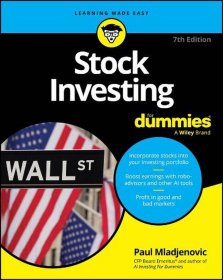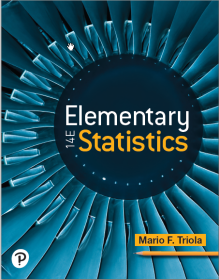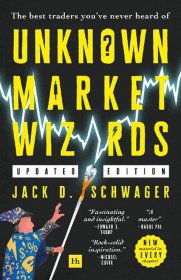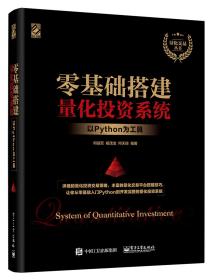
(正版) 系统投资的基础指南 Inside the Black Box: A Simple Guide to Systematic Investing--3E (需预定或E版)
(英文原版正品)下单前请先咨询,未经咨询下此单不发货。
¥ 1699 全新
仅1件
辽宁沈阳
认证卖家担保交易快速发货售后保障
作者Rishi K. Narang
出版社John Wiley & Sons Inc
ISBN9781119931898
出版时间2024
装帧精装
上书时间2024-07-03
- 店主推荐
- 最新上架
商品详情
- 品相描述:全新
- 商品描述
-
Master the basics and intricacies of quant and high-frequency trading with the latest edition of this accessible and widely-read guide In the newly revised third edition of Inside the Black Box: A Simple Guide to Systematic Investing, veteran practitioner and investor Rishi K Narang delivers another insightful discussion of how quantitative and algorithmic trading strategies work in non-mathematical terms. As with prior editions, this third edition is full of timeless concepts and timely updates. Supplemented by compelling anecdotes and real-world stories, the book explains the most relevant developments in the discipline since the publication of the second edition in 2013. You'll find out about the explosion in machine learning for alphas, signal mixing, data extraction, and execution, as well as the proliferation of alt data and a discussion of how to use it appropriately. You'll also discover:
Updated discussions of approaches to research
Newer and more effective approaches to portfolio optimization
The frontiers of quantitative investing
An essential and accessible treatment of a complicated and of-the-moment topic, Inside the Black Box remains the gold standard for non-mathematicians seeking to understand the ins and outs of one of the most fascinating and lucrative trading strategies, as well as quants from disciplines outside of finance looking for a conceptual framework on which to build profitable systematic trading strategies.
Author Biography
RISHI K NARANG is the Founding Principal of T2AM and manages the firm's investment activities. Rishi began his career as a Global Investment Strategist for Citibank Alternative Investment in 1996. He then co-founded Tradeworx, Inc., a quantitative hedge fund manager, in 1999 and acted as its President until his departure in 2002. For three years, he was the Co-Portfolio Manager and a Managing Director at Santa Barbara Alpha Strategies before founding T2AM, LLC in 2005. He is Chair of the Board of Directors of Village Health Works, and has acted as an Advisor to DARPA, Planet Labs, AngelList, and numerous others. Mr. Narang completed his BA in Economics from the University of California at Berkeley.
Table of Contents
Foreword xi Preface to the Third Edition xiii Acknowledgments xv PART ONE The Quant Universe CHAPTER 1 Why Does Quant Trading Matter? 3 1.1 The Benefit of Deep Thought 8 1.2 The Measurement and Mismeasurement of Risk 9 1.3 Disciplined Implementation 10 1.4 Summary 11 Notes 11 CHAPTER 2 An Introduction to Quantitative Trading 13 2.1 What Is a Quant? 14 2.2 What Is the Typical Structure of a Quantitative Trading System? 17 2.3 Summary 20 Notes 20 PART TWO Inside the Black Box CHAPTER 3 Alpha Models: How Quants Make Money 23 3.1 Types of Alpha Models: Theory-Driven and Data-Driven 25 3.2 Theory-Driven Alpha Models 28 3.3 Data-Driven Alpha Models 47 3.4 Implementing the Strategies 52 3.5 Blending Alpha Models 64 3.6 Summary 68 Notes 69 CHAPTER 4 Risk Models 71 4.1 Limiting the Amount of Risk 73 4.2 Limiting the Types of Risk 76 4.3 Risk Management, Outside of Risk Models 81 4.4 Summary 82 Notes 84 CHAPTER 5 Transaction Cost Models 85 5.1 Defining Transaction Costs 86 5.2 Types of Transaction Cost Models 91 5.3 Summary 96 Notes 97 CHAPTER 6 Portfolio Construction Models 99 6.1 Rule-Based Portfolio Construction Models 100 6.2 Portfolio Optimizers 104 6.3 Output of Portfolio Construction Models 121 6.4 How Quants Choose a Portfolio Construction Model 123 6.5 Summary 123 Notes 125 CHAPTER 7 Execution 127 7.1 Order Execution Algorithms 129 7.2 Trading Infrastructure 138 7.3 Summary 140 Notes 141 CHAPTER 8 Data 143 8.1 The Importance of Data 144 8.2 Types of Data 146 8.3 Sources of Data 149 8.4 Cleaning Data 152 8.5 Storing Data 158 8.6 Summary 159 Notes 160 CHAPTER 9 Research 161 9.1 Blueprint for Research: The Scientific Method 161 9.2 Idea Generation 163 9.3 Testing 166 9.4 Summary 186 Note 187 PART THREE A Practical Guide for Investors in Quantitative Strategies CHAPTER 10 Risks Inherent to Quant Strategies 191 10.1 Model Risk 191 10.2 Regime Change Risk 196 10.3 Exogenous Shock Risk 200 10.4 Contagion, or Common Investor, Risk 202 10.5 How Quants Monitor Risk 209 10.6 Summary 211 Notes 211 CHAPTER 11 Criticisms of Quant Trading 213 11.1 Trading Is an Art, Not a Science 214 11.2 Quants Cause More Market Volatility by Underestimating Risk 215 11.3 Quants Cannot Handle Unusual Events or Rapid Changes in Market Conditions 221 11.4 Quants Are All the Same 223 11.5 Only a Few Large Quants Can Thrive in the Long Run 224 11.6 Quants Are Guilty of Data Mining 228 11.7 Summary 231 Notes 231 CHAPTER 12 Evaluating Quants and Quant Strategies 233 12.1 Gathering Information 234 12.2 Evaluating a Quantitative Trading Strategy 236 12.3 Evaluating the Acumen of Quantitative Traders 239 12.4 The Edge 241 12.5 Evaluating Integrity 244 12.6 How Quants Fit into a Portfolio 246 12.7 Summary 249 Notes 251 PART FOUR High-Speed and High-Frequency Trading CHAPTER 13 An Introduction to High-Speed and High-Frequency Trading 255 Notes 259 CHAPTER 14 High-Speed Trading 261 14.1 Why Speed Matters 262 14.2 Sources of Latency 270 14.3 Summary 280 Notes 281 CHAPTER 15 High-Frequency Trading 283 15.1 Contractual Market Making 283 15.2 Non-Contractual Market Making 288 15.3 Arbitrage 289 15.4 Fast Alpha 291 15.5 HFT Risk Management and Portfolio Construction 293 15.6 Summary 295 Note 296 CHAPTER 16 Looking to the Future of Quant Trading 297 16.1 Business Models 297 16.2 Machine Learning and Artificial Intelligence 301 16.3 Expansion into More Asset Classes and Markets 302 16.4 Digitalization and Datasets 303 16.5 Man and Machine 304 16.6 Conclusion 305 Appendix: Controversy Regarding High-Frequency Trading 307 A.1 Does HFT Create Unfair Competition? 308 A.2 Does HFT Lead to Front-Running or Market Manipulation? 311 A.3 Does HFT Lead to Greater Volatility or Structural Instability? 317 A.4 Does HFT Lack Social Value? 324 A.5 Regulatory Considerations 325 A.6 Summary 327 Notes 328 About the Author 329 Index 331
相关推荐
— 没有更多了 —






















以下为对购买帮助不大的评价